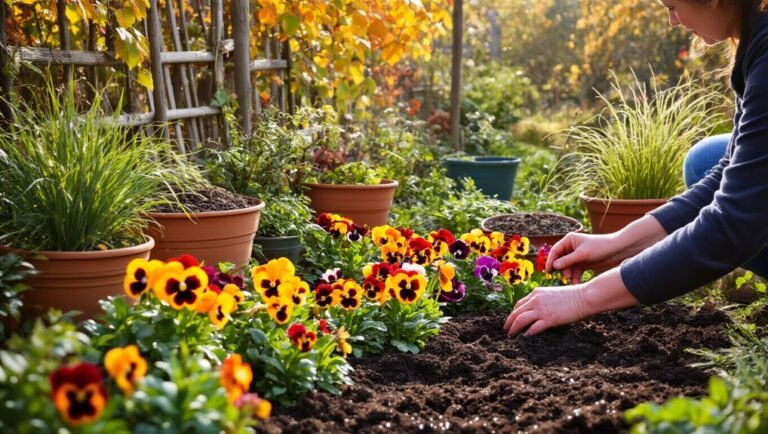To protect your plants from frost, cover them with materials like fleece, old sheets, or blankets before temperatures drop below 32°F. Ensure the cover reaches the ground to trap warmth and secure it with stakes or rocks. Water your plants in the afternoon; moist soil retains heat better. Consider using row covers for extra protection and mulch to insulate the soil. There are more creative household solutions you can explore for frost protection.
Key Takeaways
- Use lightweight fleece fabric or old blankets to cover plants before frost to trap heat effectively.
- Secure covers with stakes or rocks to prevent them from touching the plants directly.
- Water plants in the afternoon for better soil warmth retention before nighttime frost.
- Create microclimates by grouping plants together or placing them near walls for added warmth.
- Remove coverings in the morning to allow sunlight in and promote healthy growth.
Understanding Frost and Its Effects on Plants
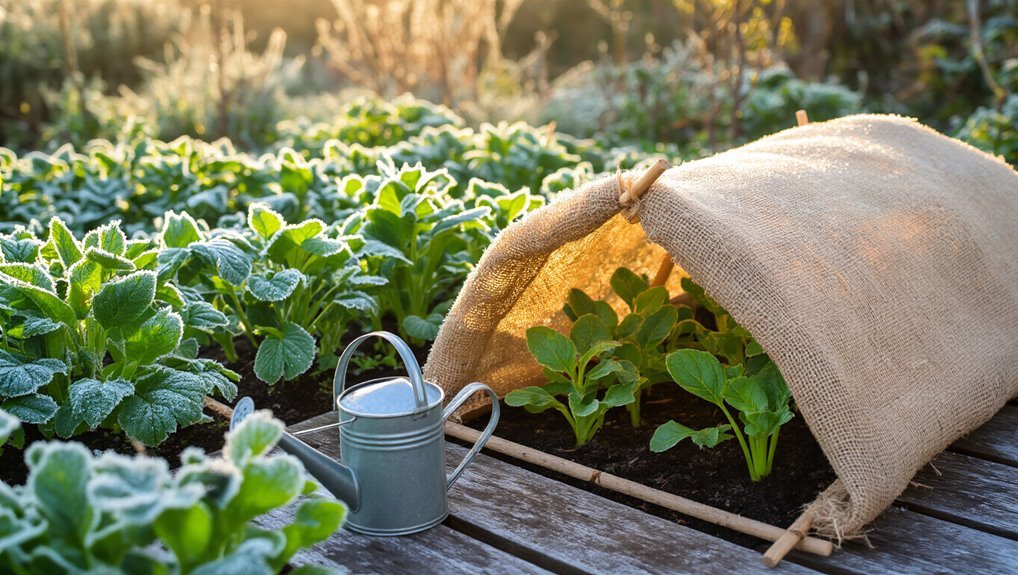
When temperatures drop, understanding frost and its effects on plants becomes crucial for any gardener. Frost forms when moisture in the air freezes, creating ice crystals that can damage plant tissues. You may notice that tender plants, like annuals or young perennials, are particularly vulnerable. Even a light frost can cause leaves to wilt or turn black, affecting their growth and overall health. Additionally, frost can disrupt delicate cell structures, leading to irreversible damage. Using frost protection covers is one of the most effective ways to shield your plants from frost, helping ensure they thrive in your garden. For added protection, you might also consider using garden netting to safeguard your plants against various environmental threats. It’s important to recognize that different plants have varying levels of frost tolerance. Familiarizing yourself with these tolerances helps you make informed decisions about protecting your garden. Being proactive can save your plants from the chilling effects of frost, ensuring they thrive in your garden.
Timing Is Everything: When to Protect Your Plants
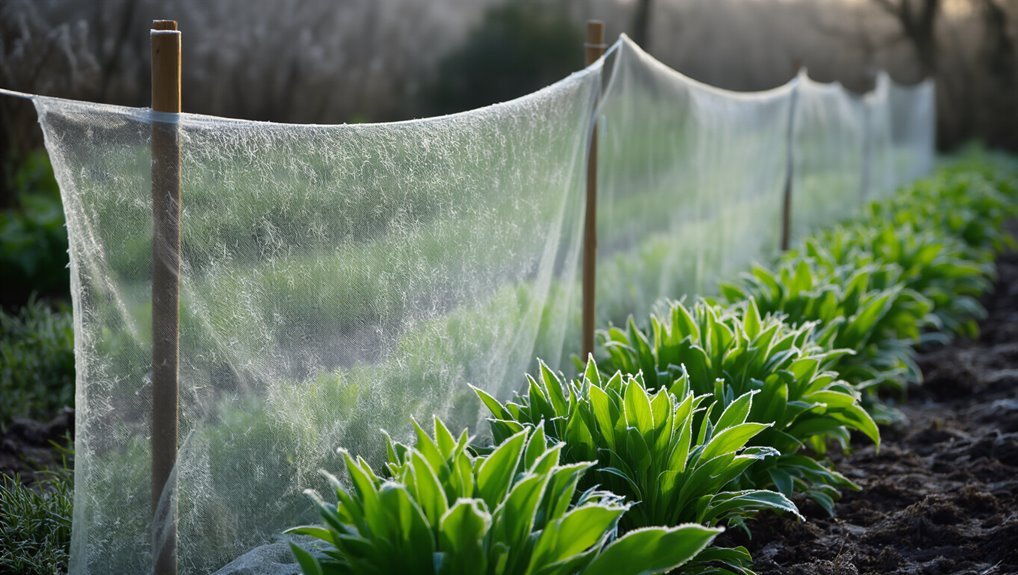
Knowing the right time to protect your plants from frost can make all the difference in their survival.
Frost typically occurs during late fall and early spring, so being proactive is key. Keep an eye on weather forecasts and be ready to act. To maximize your frost protection efforts, consider using watering cans to gently moisten the soil in the evening, as moist soil retains heat better than dry soil.
Here are some important tips to help you time your frost protection:
- Monitor nighttime temperatures; frost usually forms when it drops below 32°F (0°C).
- Watch for late-season cold snaps after a warm spell.
- Protect tender plants before the first predicted frost date.
- Use row covers or blankets during sudden temperature drops.
- Be prepared to remove coverings during the day to avoid overheating.
Utilizing drip irrigation systems can also help your garden by keeping soil moist, which may reduce frost damage in some cases.
Common Signs of Frost Damage
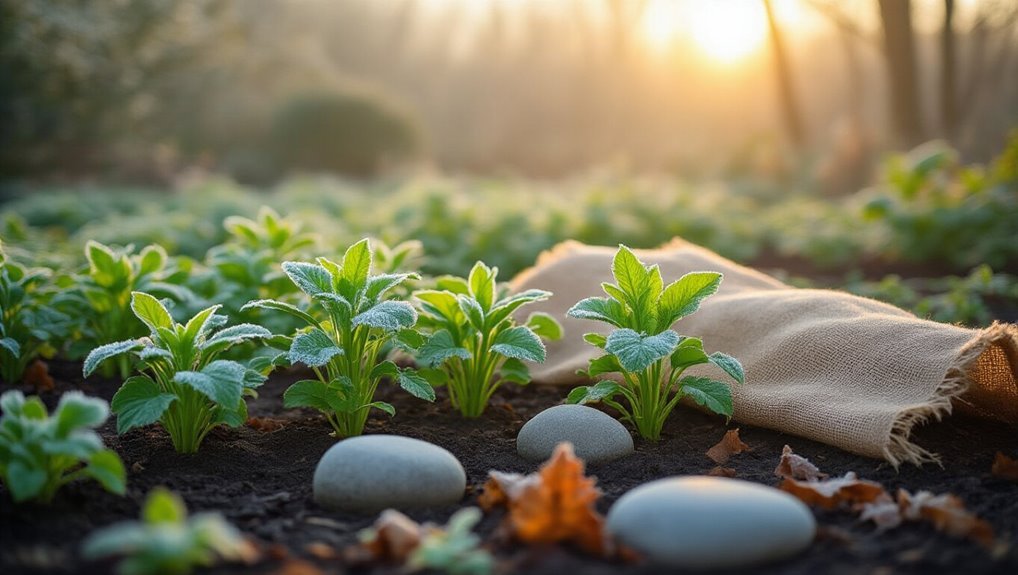
Frost can wreak havoc on your plants, and spotting the signs of damage early can help you take action. One of the first indicators is wilting or drooping leaves, which may appear discolored or waterlogged.
Check for blackened or mushy tips on new growth, as these often indicate frostbite. If you’re seeing a change in leaf color, like browning or a faded appearance, that’s another red flag. To repair frost-damaged soil, using garden trowels can help you gently work around roots and improve aeration.
You might also notice that flowers or fruit have dropped prematurely. In some cases, entire stems may become brittle and break easily.
To help manage frost-damaged branches, it’s a good idea to use pruning shears to carefully remove affected areas and encourage healthy regrowth.
Keep an eye out for these signs, and if you notice them, it’s crucial to intervene quickly to minimize further damage. Your plants will thank you!
Materials Needed for DIY Frost Covers
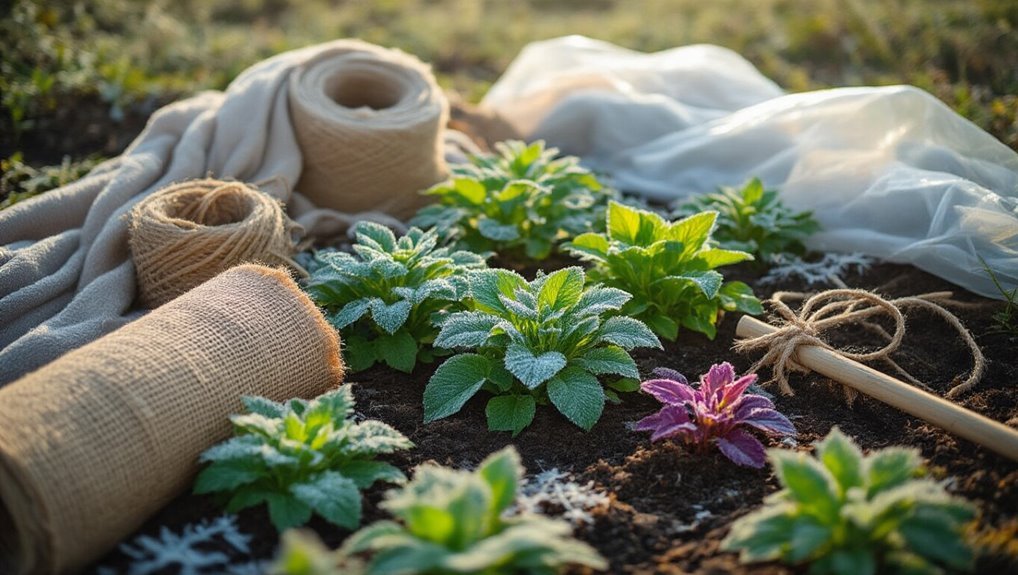
If you’ve spotted signs of frost damage on your plants, it’s time to take action and prepare for the next frost.
To create effective DIY frost covers, you’ll need a few essential materials. Here’s a quick list to get you started:
- Fleece fabric: Lightweight and breathable, it provides insulation.
- Old bedsheets or blankets: Perfect for larger plants, and they trap heat well.
- Plastic sheeting: Useful for creating a waterproof barrier.
- Rope or twine: Helps secure the covers in place.
- Stakes or hoops: Keeps the cover from touching the plants directly, preventing damage.
Gather these items, and you’ll be ready to shield your plants from the cold! For added safety and comfort while working outdoors, don’t forget to wear gardening gloves to protect your hands from thorns, dirt, and cold temperatures. To make the covering process more comfortable, consider using garden kneelers to protect your knees while working close to the ground.
How to Construct a Simple Frost Blanket
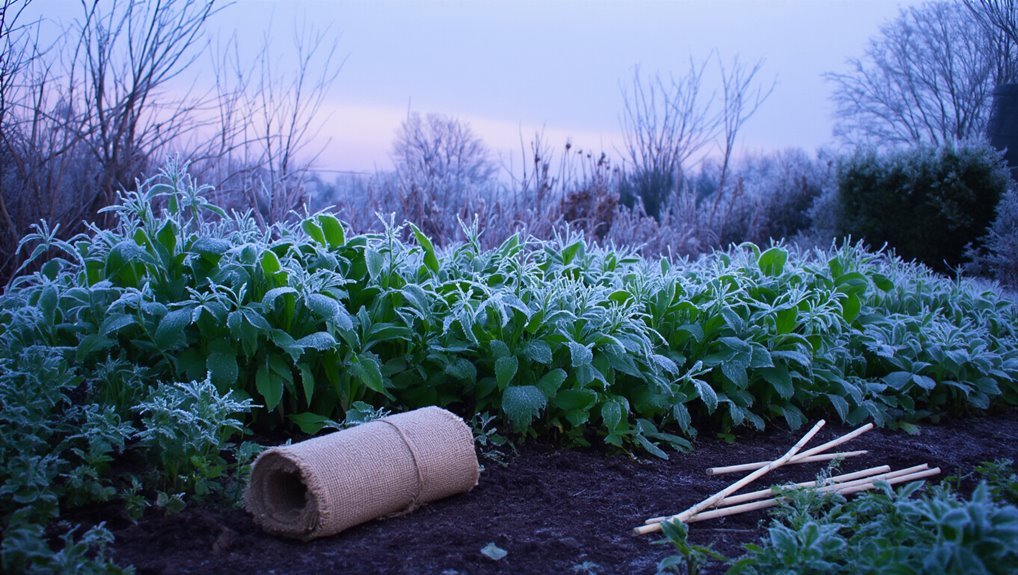
Creating a simple frost blanket is easier than you might think, and it can make a big difference in protecting your plants. Start by gathering materials like lightweight fabric, old sheets, or even burlap. Make sure the fabric is large enough to cover your plants entirely.
Next, lay the fabric over your plants in the evening before frost is expected, ensuring it reaches the ground to trap heat. Use stakes or rocks to secure the edges, preventing it from blowing away.
In the morning, remove the blanket to allow sunlight in, but be ready to cover your plants again if temperatures drop. This quick and effective solution can keep your plants safe from unexpected frost damage.
Using Row Covers for Extra Protection
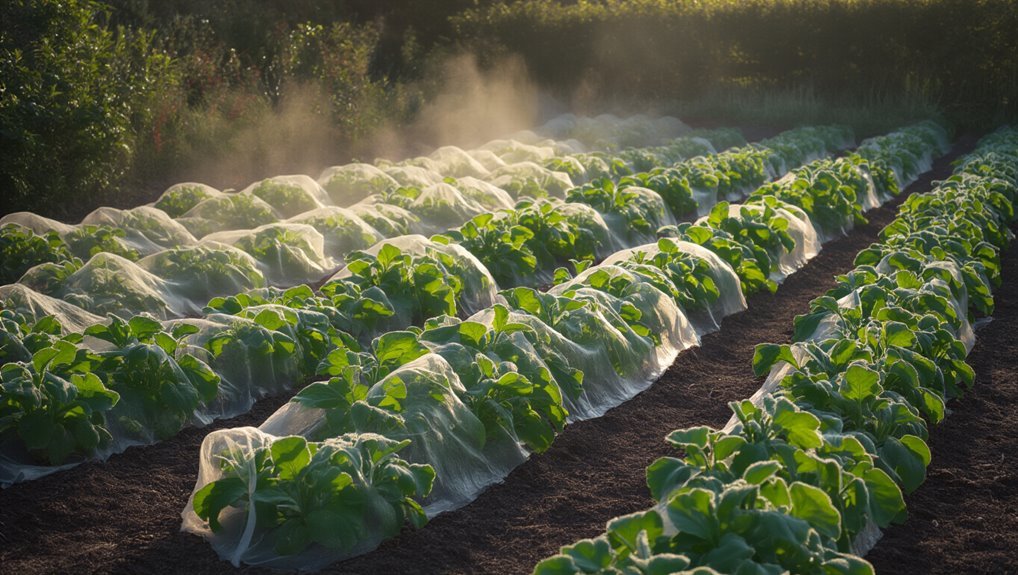
When temperatures dip unexpectedly, using row covers can provide an extra layer of protection for your plants. These lightweight fabrics trap heat and shield your plants from frost damage.
To effectively use row covers, consider the following tips:
- Choose the right material: Opt for breathable fabrics that allow light and moisture in.
- Secure the edges: Use rocks or stakes to keep the covers in place against wind.
- Monitor temperatures: Check local forecasts to know when to cover and uncover plants.
- Ventilation: Remove covers during the day if temperatures rise to prevent overheating.
- Reinforce with hoops: Create a tunnel effect for better stability and airflow.
The Benefits of Mulching Before Frost Hits
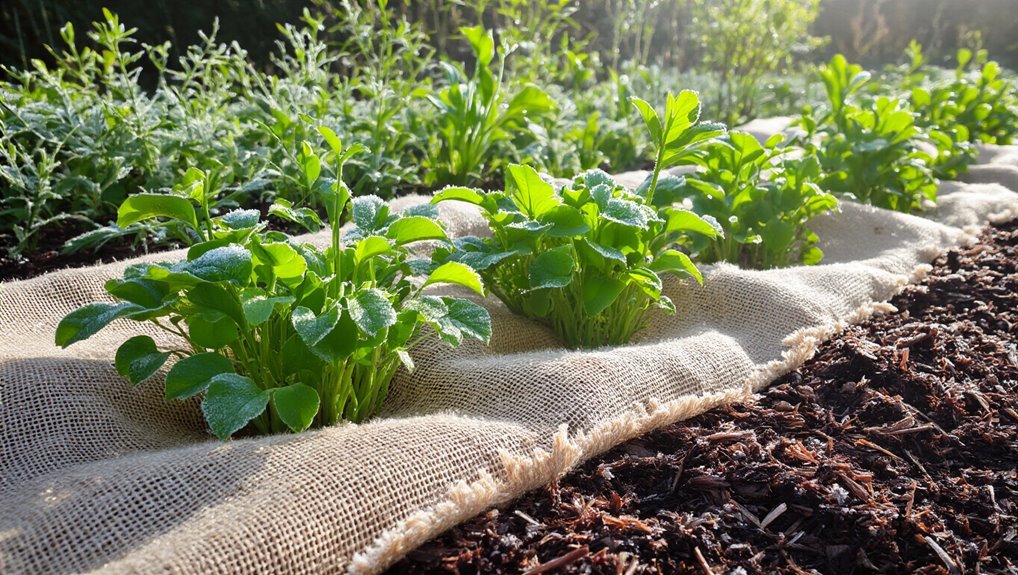
As temperatures begin to drop, mulching your garden beds can be a game-changer for protecting your plants from the harsh effects of frost. A thick layer of mulch acts as insulation, keeping soil temperatures more stable and preventing rapid cooling at night. This added warmth helps protect root systems and encourages healthy growth even as winter approaches.
Additionally, mulch retains moisture, which is crucial during colder months when plants are more vulnerable. It also suppresses weeds, reducing competition for nutrients.
Using organic materials like straw, wood chips, or shredded leaves not only benefits your plants but also enriches the soil as they break down.
Creative Solutions: Household Items as Frost Covers
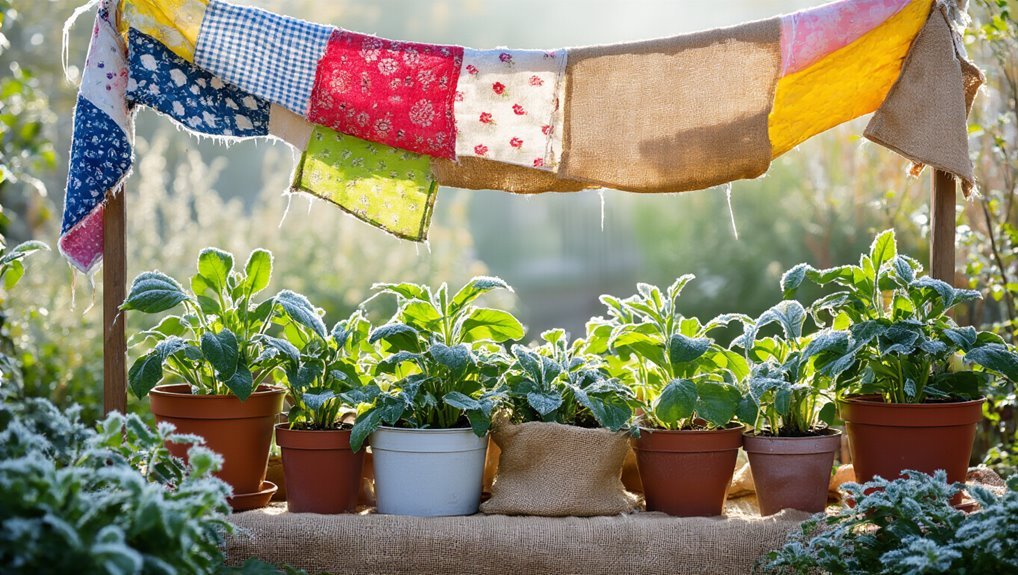
After you’ve mulched your garden beds, it’s time to think creatively about additional frost protection.
You can use everyday household items to shield your plants from chilly temperatures. Here are some effective options:
- Old bedsheets: Lightweight and breathable, they provide a cozy cover.
- Cardboard boxes: Place them over small plants for a sturdy barrier.
- Plastic containers: Use buckets or large pots upside down to protect delicate blooms.
- Towels or blankets: These offer warmth and insulation; just remember to remove them during the day.
- Cling wrap: For a snug fit around individual plants, it acts as a mini greenhouse.
Tips for Maintaining Your Garden During Frosty Weather
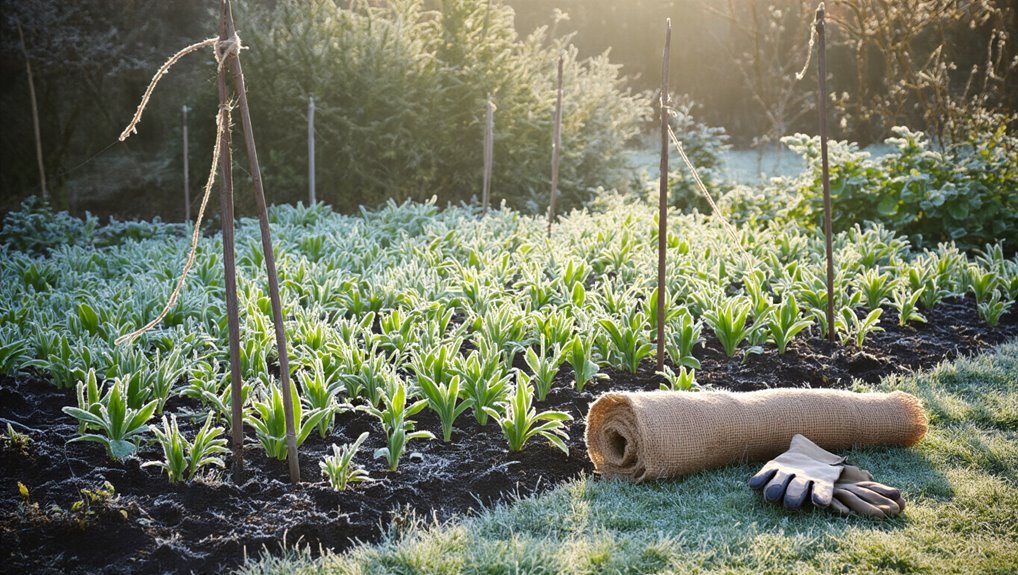
Although frost can be daunting, you can take proactive steps to keep your garden thriving during chilly weather.
Start by covering sensitive plants with frost cloths or old blankets at night, removing them in the morning. Water your plants in the afternoon; moist soil retains heat better than dry.
If possible, group your potted plants together to create a microclimate that offers warmth. Consider using row covers or cold frames for added protection.
Regularly check your plants for signs of frost damage, and prune any affected areas promptly.
Lastly, don’t forget to keep your garden tidy; removing debris can improve air circulation and reduce disease risks.
Stay vigilant, and your garden will thank you come spring!
Frequently Asked Questions
Can I Use Plastic Sheets as Frost Covers?
You can use plastic sheets as frost covers, but they may trap moisture and cause damage. It’s better to use breathable materials that allow air circulation, preventing your plants from overheating while still providing frost protection.
How Often Should I Check Plants Under Frost Covers?
Frequent frost checks are fundamental! You should inspect your plants under frost covers every morning, ensuring warmth and moisture. If conditions worsen, be ready to adjust your covers for the best protection possible.
Are There Plants That Are More Frost-Resistant?
Yes, some plants are more frost-resistant, like pansies, snapdragons, and certain herbs. You’ll find that these varieties can withstand cooler temperatures better, so consider adding them to your garden for added resilience against frost.
What Temperature Triggers Damage to Plants?
At 32°F (0°C), many plants can suffer damage. You’ll notice that tender varieties like tomatoes and peppers are particularly vulnerable, often showing signs of stress even at slightly higher temperatures if conditions are right.
How Can I Tell if My Plants Need Protection?
You’ll know your plants need protection when temperatures drop near freezing, leaves start wilting, or you see frost forming. Regularly check weather forecasts and observe your plants for signs of stress or damage.
Conclusion
As the chill of winter whispers its arrival, don’t fret about your beloved plants. By embracing these simple frost protection techniques, you can wrap your garden in a cozy embrace and shield it from the frosty nips. Remember, with a little creativity and preparation, your plants can weather the cold and emerge unscathed. So, gather your materials, and let’s keep your garden thriving through the frosty nights—because your green friends deserve a snug winter too!


